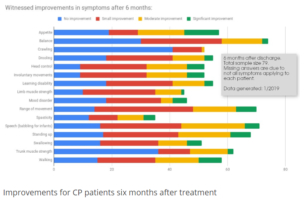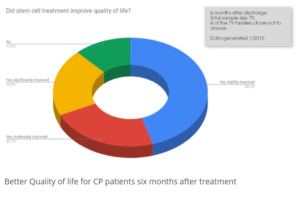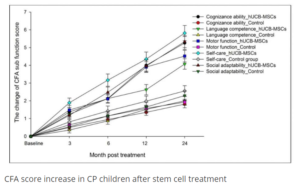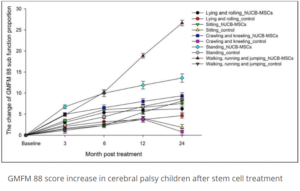Why stem cell therapy is an effective treatment for cerebral palsy
Few conventional treatment options are available for patients diagnosed with cerebral palsy, which mostly focus on helping the patients to cope with their disability. However, no conventional approach can treat the loss of neurological function caused by the original cerebral injury. Stem cell therapy for cerebral palsy (CP) has the ability to regenerate and repair damaged cells in the brain, helping to reverse the symptoms and allowing cerebral palsy patients to improve.
How does it work?
Stem cells are responsible for differentiating into new cells when old ones die or are injured. They are able to become skin, blood, muscle, bone, and more. One of the cells they can become are neurons in the brain. This creation of new cells is the source of healing, regrowth, and continued life. A stem cell treatment (injecting concentrated and potent stem cells into the body) is able to stimulate the body’s regenerative functions. This provides an extra boost and helps repairing damaged brain cells as well as creating new cells that the body needs. For neurological conditions, the most important area to send stem cells to is the brain, where they can help build new neurons for proper brain functions.
The potential mechanisms of stem cell transplantation are
- reducing the inflammation response, avoiding secondary brain lesion
- differentiating into astrocyte, microglia, oligodendrocyte, neuronland glia cells, which may be good for myeline sheath, axon regeneration, transmission of nerve impulse
- producing the cytonkines and growth factors, such as glia derived neurotrohic factor (GDNF), brain derived neurotrophic factor (BDNF), nerve growth factor (NGF), neurotrohin 3 (NT-3), neurotrohin 4/5 (NT 4/5), that support brain neuroprotection
- generating new vessels growth, thereby increasing the delivery of oxygen and nutrients to injured and hypoxic tissue; and
- reducing the intrinsic cell apoptosis.
Stem cell therapy for Cerebral Palsy
There have been many studies done on cell therapies for cerebral palsy, and clinical trials have shown that stem cells have been effective in improving CP symptoms. One of the most impressive studies to date on stem cell treatment for cerebral palsy is from Duke University in the United States. Duke conducted a randomized study of 63 CP children with different varieties and severities of spastic cerebral palsy. The children’s parents had placed their child’s cord blood stem cells in a blood bank after birth, and after the children were treated with their own cord blood cells, they were shown to see improvements in their motor function just a year later. These improvements were better than those of other CP children of similar age and condition, and better than those that were given fewer stem cells or none at all. One of these children’s stories can be found here. Senior author of the study Joanne Kurtzberg, M.D., is the director of Duke’s Pediatric Blood and Marrow Transplant Program and the Robertson Clinical and Translational Therapy Program. She strongly believes in stem cell treatment for cerebral palsy, saying, “previous research has indicated it’s safe for children with cerebral palsy to receive an infusion of their own cord blood.
Potential improvements after the treatment
The purpose of the treatment is to promote healing of the original spinal cord/brain injury in order to restore neurological function. Thus, various kinds of improvement are possible after our treatment. The majority of Cerebral Palsy patients that have been treated by Beike, utilizing the combination of stem cell therapy and rehabilitation, showed visible signs of improvements, especially for these symptoms:
- Spasticity
- Range of movement
- Speech
- Walking
- Balance
- Swallowing
- Learning
- Mood disorder
- Head control
- Drooling and appetite
Our patients have seen excellent results after a stem cell therapy for cerebral palsy. Below are two graphs generated by the data provided to us by our patients in our follow up program after treatment. The first graph is showing our patients’ response to the question if the treatment did improve life quality. Our follow-up data shows that out of 75 patients treated previously (4 did not respond), 88% have enjoyed substantial improvements in their quality of life within 6 months after treatment. The second graph shows the most common improvements in symptoms after the treatment. Not all symptoms apply to all patients, and therefore the numbers can be uneven across symptoms. Please also note that the degree of improvement for each symptom has been subjectively assessed by the families of the patient treated and families had to choose between “no improvement”, “small improvement”, “moderate improvement” and “significant improvement” to describe the outcome for each symptom.
*It is important to remember that as for any medical treatment, improvements cannot be guaranteed. Please contact us for more information regarding the possible improvements for a particular case.
Clinical trials and studies
There have been many studies done on cell therapies for cerebral palsy, and clinical trials have shown that stem cells have been effective in improving CP symptoms. One of the most impressive studies to date is from Duke University in the United States. Duke conducted a randomized study of 63 CP children with different varieties and severities of spastic cerebral palsy. The children’s parents had placed their child’s cord blood stem cells in a blood bank after birth, and after the children were treated with their own cord blood cells, they were shown to see improvements in their motor function just a year later. These improvements were better than those of other CP children of similar age and condition, and better than those that were given fewer stem cells or none at all. One of these children’s stories can be found here. Senior author of the study Joanne Kurtzberg, M.D., is the director of Duke’s Pediatric Blood and Marrow Transplant Program and the Robertson Clinical and Translational Therapy Program. She says, “previous research has indicated it’s safe for children with cerebral palsy to receive an infusion of their own cord blood.
Though there is a lot of hope and excitement surrounding stem cell therapy, clinical trials are still working to catch up to the hype. While many clinical trials for CP are still underway, many have already been published, that show the safety of stem cells and their efficacy.
One study recently (2018) measured the efficacy of human umbilical cord blood mesenchymal stem cell infusion for children with cerebral palsy. The study chose to use human umbilical cord blood-derived MSCs (hUCB)-MSCs) because their use encounters fewer ethical dilemmas, the cells have comparatively low immunogenicity as well as immunosuppressive ability (meaning they are less likely to produce an immune response), and they have a higher rate of proliferation.
Stem cell treatment for cerebral palsy combined with rehabilitation has shown positive results and is the most commonly preferred option and this combination method was used for the study as well. The graphs of the changes in the Gross Motor Function Measure (GMFM-88) score (the measurement tool for severity of CP in terms of motor function) and the comprehensive functional assessment (CFA) score (a more comprehensive measurement that includes cognizance and comprehension) can be seen in the graphs below.



